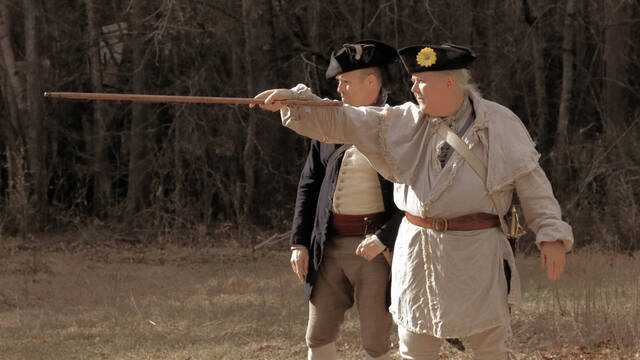
Visitors to Moores Creek National Battlefield will be treated to an immersive history lesson focusing on the first decisive patriot victory of he Revolutionary War.
Photo ourtesy National Park Service
The National Park Service will provide a unique opportunity on Oct. 14 when it hosts “Outlander at Moores Creek National Battlefield.”
Park staff, volunteers and visitors will explore “The Ghost of Culloden” from Diana Gabaldon’s book, “A Breath of Snow and Ashe.”
Moores Creek National Battlefield’s “Outlander at the Battle of Moores Creek Bridge” is a bi-annual Scottish Heritage Day Event on set for 10 am to 3 pm.
This year’s program will be centered on the acclaimed “Outlander” book series and will include tours discussing the difference between Diana Gabaldon’s take on the Battle of Moores Creek Bridge and actual events.
The event will include Highland Soldiers, colonial trades such as blacksmithing, Scottish dancers, guest speakers, bagpipers and more.
Ranger Jason Howell will provide guided tours of the Moores Creek Battlefield, located just south of Currie, focused on the accounts of the battle depicted in the Outlander book series, as compared to firsthand accounts of the battle. These tours will be offered at 10 a.m. noon and 2 p.m. The tours meet in Patriot’s Field.
The Wilmington Police Pipes and Drums will perform at noon and 2 pm in the Colonial Music area in Patriot’s Field.
Guest speaker times inside Patriot’s Hall will be as follows:
11 a.m.: Christine Lamberton, Site Manager, Burgwin-Wright House and Gardens – Outlander and the Cape Fear podcast.
1 p.m.: Catherine Fort – President, Scottish Society of Wilmington –
Curious about the Gaelic languages? A Gaelic Primer session will provide an opportunity to learn about the differences in the six Gaelic languages, the efforts to save the languages in modern day and some basic lessons in speaking the language of the Highland Scots.
While not a fluent speaker, Catherine Fort will use her knowledge and trusty English-Gaelic dictionary to try to help decipher words and phrases you might want to know.
Catherine became interested in learning Gaelic during a visit to Scotland in 2001.
On returning home, she was surprised to find that her county public school’s adult education program offered a Gaelic class.
She spent eight years meeting with a class weekly, and picked up her studies again during the Pandemic Pause.
Making no claim to being fluent, or to having perfect pronunciation and grammar, she said she hopes to share some of her knowledge with others.
3 p.m.: Dr. Kimberly Sherman, Associate Professor, Cape Fear Community College.
The History
North Carolina was a deeply divided and fractured colony prior to the American Revolution, making it a prime target for a British invasion.
Looking to take advantage of the situation, the British Crown planned to send 7,000 regular British troops, with an addition of 10,000 muskets and small artillery to supply those colonists still loyal to the British government.
By April 1775, British Royal Governor of North Carolina Josiah lost control of the colony and was sent into exile. While in exile Martin laid plans to re-take North Carolina. He would raise an army of 10,000 and march it to a coast to link up with British forces. Martin persuaded his London and North American superiors that his plan would restore royal rule in the Carolinas—but he could raise only 1,600 loyalist soldiers.
In August and September 1775, at news of the loyalists assembling under General Donald MacDonald at Cross Creek (Fayetteville) the patriots began gathering forces.
Colonel James Moore was given over all command of patriot forces in the colony. In Wilmington they threw up breastworks and prepared to fight. New Bern authorities musteredminute men and militia under Col. Richard Caswell with orders to defend the colony.
The loyalists planned to join British forces at the coast to restore royal authority in the colony. On February 20, 1776, the loyalists moved towards the coast, but was blocked by Moore’s patriot forces from Wilmington. The loyalists then moved east to evade Moore while hoping to also slip past Caswell’s force coming from New Bern.
For the next few days, the Loyalists sought an open route to the coast, but found Caswell’s force blocking their path along the Black River. The loyalists, finding a different crossing point over the Black River the next day, forced Caswell and his men to take up a strong position at the bridge crossing Moores Creek.
Caswell was reinforced by 200 minutemen from the Wilmington District at Moores Creek Bridge. The patriots used the natural terrain of the creek to their advantage, placing strong earthwork on a ridge overlooking the creek on the east bank. By Feb. 26, 1776 the loyalists were camped six miles from the patriot position.
Late that afternoon the loyalists sent a courier to Caswell’s camp to offer a chance for the patriots to lay down their arms. Caswell refused the proposal.
Upon returning to General MacDonald, the loyalist courier conveyed that the patriots were camped on the west bank of Moores Creek and vulnerable to attack. The courier did not see the earthworks on the east bank. With only partial information of the patriots position the loyalists plan their attack. They begin marching about 1:00 am, on February 27. During the night the patriots move their forces to the east bank and awaited the loyalist attack.
At 5 a.m. the loyalists learned the patriots abandoned their camp on the west bank. Believing the patriots were fast retreating the loyalists pushed across a partially dismantled Moores Creek Bridge, up a long narrow dark causeway, where they were met with musket and cannon fire from the patriot earthworks. The battle of Moores Creek was brief, possibly lasting only three minutes. This battle would mark the first decisive Patriot victory of the American Revolution. Allowing North Carolina to become the first American colony to instruct their delegates sent to the Continental Congress, to vote for independence.
Source: The National Park Service







